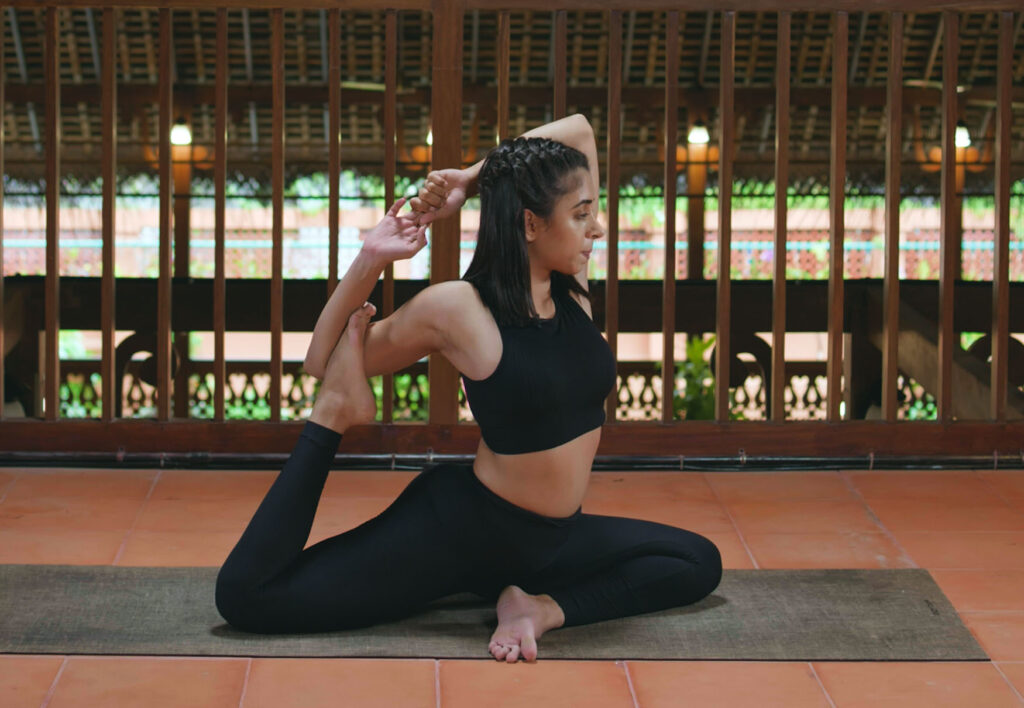
When you do Yoga correctly, you don’t need to know everything about its history to gain from it. On the other hand, having a rudimentary understanding of Yoga’s history may drive you to learn more about the discipline’s past and aid you with your spiritual practice.
The first yoga literature in Sanskrit was found in early religious texts known as the “Vedas” in India. The word “Yoga” can mean several different things. The verb “yug” means “to hook up,” and the word “yug” relates to the action of fastening horse bridles to a wagon. Yoga, however, also denotes actively using, joining, or uniting. Yoga is increasingly generally regarded as a discipline or a way to join. The terms “Yogi” and “Yogin” are used to refer to yoga practitioners, while “Yogini” is used for women.
Yoga is an exercise program for the body and mind performed for over 5000 years. It promotes living in the now and being mindful. Because it brings attention back to the now in a constantly changing society where people are frequently focused on the future rather than the present, Yoga is more popular today than ever. There are several variations of Yoga, all of which are derived from the old tradition. Choosing which yoga style to practice first could be challenging for a beginner. You can only figure out which style best suits you by trying various options.
This article will briefly overview some of the most well-liked yoga styles.

1. Hatha Yoga
Traditional “Hatha Yoga” consists of simple physical positions and breathing techniques often done slowly and steadily with breaks in between. The majority of yoga practices in the West are Hatha-inspired; however, each style differs in terms of the emphasis it places on breathing and meditation as well as the “Asanas,” or natural poses. Hatha strongly emphasises correctly executing the classic poses in accordance with the body’s capacities. In Sanskrit, “ha” denotes the sun, while “the” denotes the moon. Hatha represents masculine and feminine, yin and yang, darkness and light. The goal of Hatha Yoga is to achieve harmony between these opposing forces.

2. Vinyasa Yoga
Vinyasa, derived from the Sanskrit term for “flow,” is a dynamic style of Yoga that emphasises the synchrony of breath and movement. It involves a fluid sequence of postures, transitioning seamlessly from one pose to another. Vinyasa Yoga generates internal heat in the body, intensifying the practice and promoting purification through sweat. With fewer pauses than Hatha Yoga, Vinyasa Yoga offers a continuous and stimulating experience, building strength, flexibility, and a heightened mind-body connection. It cultivates a sense of flow and vitality while purging toxins through the cleansing process of perspiration.

3. Ashtanga Yoga
Sri K. Pattabhi Jois teaches “Astanga Yoga,” often called “Ashtanga Yoga,” in Mysore, India. He brought “Astanga Yoga” to the West about 25 years ago; at 91 years old, he is still instructing. Physically intensive yoga styles like Ashtanga provide strength, flexibility, and endurance training. It portrays the distinctive Hatha yoga style the legendary sage Vamana Rishi developed and practised. It’s said to be the first asana Patanjali intended to be performed. A series of Yoga poses known as “Astanga Yoga” are performed continuously without stopping. The breathing and the movements must be coordinated, just like in “Vinyasa Yoga”.
A specific order must be followed when performing Astanga Yoga poses. The body is cleansed and detoxified during the Primary Series (Yoga Chikitsa), preventing pollutants from clogging. The Intermediate Series (Nadi Shodhana), which purifies and opens energy pathways to let the energy flow freely, decongests the nervous system. One must pass from the previous posture to move on to the following one.

4. Bikram Yoga
Even though there are many types of Yoga, “Bikram yoga” stands out. Even while the technique is identical, the environment is different: “Bikram yoga” is practised in a room heated to a temperature between 90 and 100 degrees Fahrenheit!
The inventor of this style of Yoga is Yogi Bikram Choudhury, who began his yoga studies with the renowned physical culturalist Bishnu Ghosh when he was just three years old. They developed this technique as one of the best ways to help the body transition through challenging stretches and positions. Since some postures are more complicated than others, a beginner in Bikram will require the help of a skilled teacher to get started.
The intense heat of Bikram yoga is meant to assist you in finding a deeper, more stable posture. The body becomes more flexible due to the heat, which makes it easier to adopt better postures and boosts the efficiency of the entire workout. The heat will help you enter some of the more challenging Bikram yoga postures more comfortably and, hopefully, benefit more from them. Additionally, as the temperature rises, your body will sweat more readily, which will cause your pores to release more contaminants. The heat also decreases your risk of getting wounded.
Your muscles are stretched and strengthened when you practice “Bikram yoga”. With Bikram yoga, you may strengthen and improve your muscles, joints, and ligaments. Additionally, you are rubbing and working on your inside organs, which helps to lubricate and build the body’s glands and strengthen the nervous system. All of this exercise, especially in the environment created by Bikram, helps the body rid itself of toxins and provides the training your muscles need.

5. Yin Yoga
Yin Yoga, developed by Paul Grilley, is a gentle and calming style emphasising deep stretching and finding balance within the body. It integrates principles from Taoism, Chinese acupuncture, and Indian yoga philosophy. In Yin Yoga, poses are held for an extended duration, allowing for a deep release of tension and stimulation of the body’s meridian lines. This meditative practice nurtures flexibility, mindfulness, and a profound sense of relaxation, promoting harmony between the physical and energetic aspects of being.

6. Power Yoga
A variation of Yoga based on “Astanga Yoga” called “Power Yoga” is intended for people who enjoy strenuous exercise. In order to help you connect with your inner strength, power yoga is a high-intensity yoga practice that blends mental and physical challenges with a heated, climate-controlled Vinyasa flow. It stimulates the body and minds through balance and purpose while healing and detoxifying them. This kind of Yoga is prevalent in gyms and fitness facilities. Despite having Astanga yoga as its foundation, it frequently incorporates many other styles of Yoga, creating a very active yoga session.
Power yoga is a vigorous exercise that combines physical strength, sweat, and spirituality. It distinguishes between three kinds of power: mental, spiritual, and physical. The three types of power are spiritual power, which is the force that underlies the physical and mental force, and physical power, which increases the body’s strength and promotes health.

7. Iyengar Yoga
Do you experience recurring back pain or other physical limitations? You want to narrow your attention and reduce your level of stress. Attend a meditation class. I’m trying to find a challenging workout. “Iyengar Yoga” was developed by B.K.S. Iyengar, one of the most well-known yoga teachers in the world. An Iyengar-based class would be fantastic because of its emphasis on proper form and the use of props. The physical positions place a lot of emphasis on accuracy, good posture, and straight lines. The frequent use of accessories like blocks and belts is another characteristic of this yoga technique. Each pose in “Iyengar Yoga” is frequently held for a lengthy amount of time, and breathing heightens its effects.

8. Tri Yoga
Tri Yoga is a holistic yoga practice that harmoniously blends breathwork, physical postures, and a balanced combination of dynamic and static poses. Created by Kali Ray, it incorporates wave-like movements of the spine and specific breathing techniques. With its seven levels of intensity, Tri Yoga offers a progressive path for practitioners to deepen their practice and explore meditative content. It promotes balance, flexibility, and a conscious connection between the body, breath, and mind.

9. Sivananda Yoga
A variety of “Hatha Yoga”, known as “Sivananda Yoga”, was named for Swami Sivananda’s teachings. The emphasis of the training is on keeping the practitioner happy and healthy.
Sivananda training emphasises consistent relaxation and deep, yogic breathing more than the more athletic Ashtanga Vinyasa style of Yoga.
A moderate kind of Yoga called “Sivananda Yoga” promotes meditation, vegetarianism, and having a cheerful outlook. Swami Vishnu-Devananda developed this yoga style. Instruction in “Sivananda Yoga” may include chanting, meditation, and profound relaxation.

10. Kundalini Yoga
Even though the emphasis is on chanting and breathing techniques, “Kundalini Yoga” also incorporates physical training. Yoga practitioners are familiar with Kundalini as the snake-like power in the Muladhara Chakra, the first of the seven Chakras. In that order, the other six chakras are Svadhishthana, Manipuraka, Anahata, Visuddha, Ajna, and Sahasrara. The intention is to awaken the Kundalini energy at the base of the spine, help it ascend the spine via the body’s chakras, and then direct it to your brain, where it will produce a rich spiritual experience.
Even while it might be unrealistic to try all the many kinds of Yoga, getting a taste of some of the crucial branches, like Kundalini yoga, will help you comprehend the benefits and core principles of Yoga. On the other hand, Kundalini Yoga isn’t just another form of exercise. Kundalini is a powerful force that should only be used under the guidance of an experienced teacher. It is called the “mother of all yoga” and is one of the most substantial types.

Hello would you mind stating which blog platform you’re using? I’m planning to start my own blog in the near future but I’m having a hard time selecting between BlogEngine/Wordpress/B2evolution and Drupal. The reason I ask is because your design and style seems different then most blogs and I’m looking for something unique. P.S Sorry for being off-topic but I had to ask!
I’m not sure why but this blog is loading slow for me. However, this site is really awesome. Great information.
I do not even know how I ended up here, but I thought this post was good. I do not know who you are but definitely you are going to a famous blogger if you are not already 😉 Cheers!
Thanks for posting. I really enjoyed reading it, especially because it addressed my problem. It helped me a lot and I hope it will help others too.